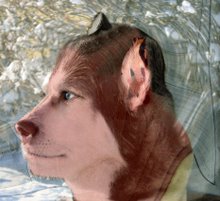I've been fooling with some old images using Google's Deep Dream software. Here's a couple. One can click on them and right click to view largest versions. The first is a collage I made from an older collage and a photo from around 1985 of Jim Morrison's grave near Paris. The second is a painting I did that took about 7 years to finish (!) in about 1998, and which I ran through the Deep Dream software today.
Sunday, November 15, 2015
Saturday, November 14, 2015
Sunday, August 16, 2015
Doesn't Like Color Pink
This lady has a pink sweater and is sitting on a pink kayak, knitting another pink sweater, next to her pink carryall bag. Her pink water bottle rests on the curb. I got the orange kayak in the background. It leaked.
Saturday, May 9, 2015
Video Trickery, Computers and the Internet
Regarding citizen videos, at present there's a large gap which needs to
be dealt with, and it's a gap of gullibility regarding computers, the
internet and video trickery.
I think there are a lot of tricks the public in general needs to be reminded about. If you need a history of them, I don't know how far back you want to go but I think about the TV show 60 Minutes, because it became clear they'd interview someone and then replace the questions they really asked them later with shots of them asking different but similar questions. Subtle manipulations.
Another I've thought of is the one where you are shown a video, it's said that this is a view of, for example, a police raid during the aftermath of the Boston bombing, but in reality it's a video of some other police interaction at a different time and perhaps place. taken at the usual distance, i.e., fairly far away. How would one know? How often have you watched one and assumed its provenance was as indicated, yet with no reason to really believe it?
Sequencing is often played with. One event is shown, then another, and the viewer assumes that at the actual event, this happened, one-two, just like that. Yet if there was any cut from a scene, it's possible the video was edited to suppress knowledge of intervening events or situations.
.
Lately we've seen actual political stunts pulled like this. The O'Keefe ACORN video was done like that.
One of Obama's employees got fired in a separate incident for out-of-context video.
People are believing video which should not be necessarily believed.
Once this gullibility is fixed, we can proceed with the transparency progress.
I think there are a lot of tricks the public in general needs to be reminded about. If you need a history of them, I don't know how far back you want to go but I think about the TV show 60 Minutes, because it became clear they'd interview someone and then replace the questions they really asked them later with shots of them asking different but similar questions. Subtle manipulations.
Another I've thought of is the one where you are shown a video, it's said that this is a view of, for example, a police raid during the aftermath of the Boston bombing, but in reality it's a video of some other police interaction at a different time and perhaps place. taken at the usual distance, i.e., fairly far away. How would one know? How often have you watched one and assumed its provenance was as indicated, yet with no reason to really believe it?
Sequencing is often played with. One event is shown, then another, and the viewer assumes that at the actual event, this happened, one-two, just like that. Yet if there was any cut from a scene, it's possible the video was edited to suppress knowledge of intervening events or situations.
.
Lately we've seen actual political stunts pulled like this. The O'Keefe ACORN video was done like that.
One of Obama's employees got fired in a separate incident for out-of-context video.
People are believing video which should not be necessarily believed.
Once this gullibility is fixed, we can proceed with the transparency progress.
Friday, January 16, 2015
The Mountain of Lies Technique OR Brandolini’s Law
-
In July 2010 I wrote on David Brin's site here this thought:
"I began to recognize some time ago what I call the "mountain of lies" technique of political gamesmanship. A lie requires limited space, thought, and effort. Its refutation takes more space, time, and effort than the lie does. It's like missile defense.
"To be clear, on this matter the deniers spew the lies, and the scientific researchers are stuck with the effort.
"One supposes that some good can come from this, but it's an uphill slog and people should be aware of the tactic itself and not be sucked in without awareness of the structure of the common trap."
Preceding that, in 2009 someone called Mike the Mad Biologist wrote this essay (April 2009) titled "The Asymmetric Advantage of Bullsh-t" framing this as a problem similar to a decryption function - it's easier to encode a message than to decode, if your algorithm is one of a certain class. He mentions the inspiration for this line of thinking came from Julian Sanchez also in April of 2009.
Now this is referred to as "Brandolini's Law," from a remark Alberto Brandolini wrote in January 2013. Discussed here as the "Bullshit Asymmetry Principle."
"The amount of energy needed to refute bullshit is an order of magnitude bigger than to produce it.”
Also referenced is that the concept may also refer to the teoria della montagna di merda (“the Bullshit Mountain Theory”) as postulated by Uriel Fanelli, another Italian writer.
I suggest it is properly "Sanchez's Law" or "Fanelli's Law" but probably the recognition of it is more important than the name of it.
As a matter of fact, it's been around much longer, known as the Gish Gallop from "creationist" Duane Gish, and was named such by one Eugenie Scott.
Bullshit is well described here.
Subscribe to:
Comments (Atom)








